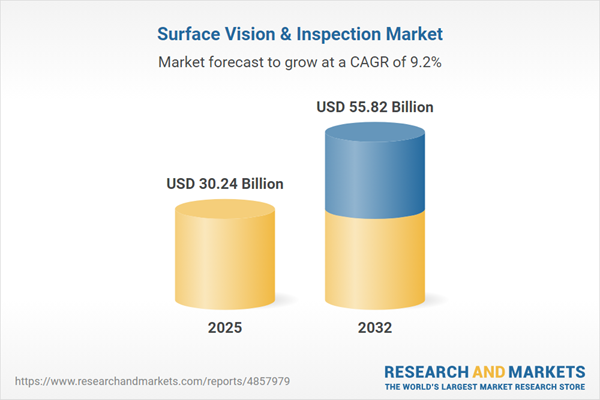Speak directly to the analyst to clarify any post sales queries you may have.
Surface vision and inspection systems have become an integral asset for organizations seeking to reinforce quality assurance and streamline manufacturing processes. As global industry expectations shift, senior decision-makers are turning to these technologies to support long-term value and operational transparency.
Market Snapshot: Surface Vision & Inspection Systems
The surface vision and inspection systems market is valued at USD 27.70 billion in 2024 and is projected to reach USD 30.24 billion by 2025, with a forecast of USD 55.82 billion by 2032. This steady growth is propelled by the widespread adoption of automation and digital transformation, particularly in industries where manufacturing precision and compliance are critical. Senior leaders are responding to regulatory demands and evolving client expectations by directing investments toward advanced imaging platforms and intelligent process controls. Emphasis continues to grow on solutions that reinforce quality standards while enabling adaptability in production settings.
Scope & Segmentation: Surface Vision and Inspection Systems Market
This market analysis employs robust segmentation to help business leaders identify priority areas and align technology investments with organizational goals. Targeted segmentation offers clarity on growth drivers and the unique requirements of varied industries:
- Component: Industrial cameras, precision optics, advanced lighting, high-speed processors, analytics software, and a spectrum of services including consulting, installation, and maintenance support modern inspection solutions.
- Technology: Diverse techniques such as laser triangulation, photometric stereo, structured light, stereoscopic imaging, and time-of-flight sensors support comprehensive defect detection across challenging manufacturing lines.
- Type: Systems range from 2D flaw detection modules to fully integrated 3D analysis platforms, as well as multichannel and infrared-based solutions for in-depth and complex inspection tasks.
- Application: Platforms address assembly verification, dimensional measurement, barcode and print quality assurance, and micro-defect detection to provide traceability and reliability, particularly within regulated sectors.
- End-Use Industry: Adoption is evident across automotive, electronics, semiconductors, healthcare, pharmaceuticals, food and beverage, metals, mining, packaging, logistics, and warehousing sectors, each capitalizing on tailored inspection approaches to meet market demands.
- Deployment Mode: Both cloud-based analytics and on-premise systems are available, supporting scalability, local control, and responsive analysis depending on the operational context.
- Regional Coverage: Adoption patterns are influenced by regulatory frameworks, sector maturity, and manufacturing needs across the Americas, Europe, Middle East & Africa, and Asia-Pacific.
- Top Providers: The market includes Cognex, Keyence, Omron, Teledyne, Basler, ISRA VISION, SICK, National Instruments, Datalogic, and Panasonic, ensuring a wide array of technology options and specialist support for diverse operational requirements.
Key Takeaways for Senior Leaders
- Implementing surface vision and inspection systems addresses inconsistencies, bolsters product quality, and aligns production with stringent regulatory standards.
- Integrating artificial intelligence and edge computing significantly decreases manual oversight, enhancing real-time response capabilities and resource effectiveness.
- Continual developments in imaging and adaptive lighting enable organizations to quickly adjust to new compliance rules and tailored production specifications across multiple product lines.
- Modular and customizable software allows organizations to adapt workflows, drive rapid product development, and pivot in response to shifting market or client needs.
- Augmenting systems with robotics and secure cloud infrastructure strengthens supply chain resilience and improves predictive maintenance, minimizing the likelihood of unexpected downtime.
Tariff Impact on Surface Vision & Inspection Supply Chains
Shifts in United States tariff policies have prompted manufacturers to rethink sourcing strategies and enhance procurement agility. Resilient supply networks and proactive adaptation to evolving trade structures have become essential for sustainable operations and risk management in this market.
Methodology & Data Sources
All findings are underpinned by structured executive interviews, comprehensive sector surveys, and technical validations. This approach ensures each insight is relevant, actionable, and benchmarked against established best practices, offering value for senior leadership decision-making.
Why This Report Matters for Market Leaders
- Guides technology investment aligned with changing operational, industry, and compliance frameworks, ensuring resources target sustainable growth opportunities.
- Presents in-depth, actionable segmentation to help decision-makers identify emerging growth segments and optimize business response.
- Supports procurement and supplier strategy by equipping organizations to proactively manage risks and rapidly adapt to changing regulatory or sourcing requirements.
Conclusion
Surface vision and inspection systems equip manufacturers with actionable tools to uphold quality, strengthen process resilience, and respond to an evolving regulatory environment. Strategic adoption empowers leaders to sustain effective operations amid ongoing market change.
Additional Product Information:
- Purchase of this report includes 1 year online access with quarterly updates.
- This report can be updated on request. Please contact our Customer Experience team using the Ask a Question widget on our website.
Table of Contents
3. Executive Summary
4. Market Overview
7. Cumulative Impact of Artificial Intelligence 2025
Companies Mentioned
The companies profiled in this Surface Vision & Inspection market report include:- Cognex Corporation
- Keyence Corporation
- Omron Corporation
- Teledyne Technologies Incorporated
- Basler AG
- ISRA VISION AG
- SICK AG
- National Instruments Corporation
- Datalogic S.p.A.
- Panasonic Holdings Corporation
Table Information
| Report Attribute | Details |
|---|---|
| No. of Pages | 189 |
| Published | November 2025 |
| Forecast Period | 2025 - 2032 |
| Estimated Market Value ( USD | $ 30.24 Billion |
| Forecasted Market Value ( USD | $ 55.82 Billion |
| Compound Annual Growth Rate | 9.1% |
| Regions Covered | Global |
| No. of Companies Mentioned | 11 |









